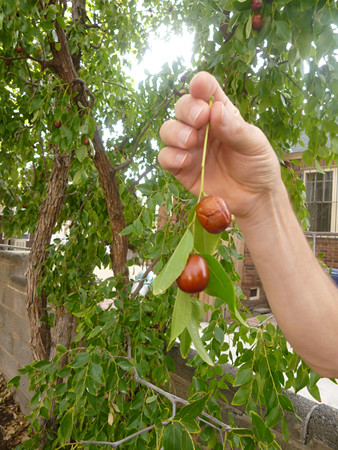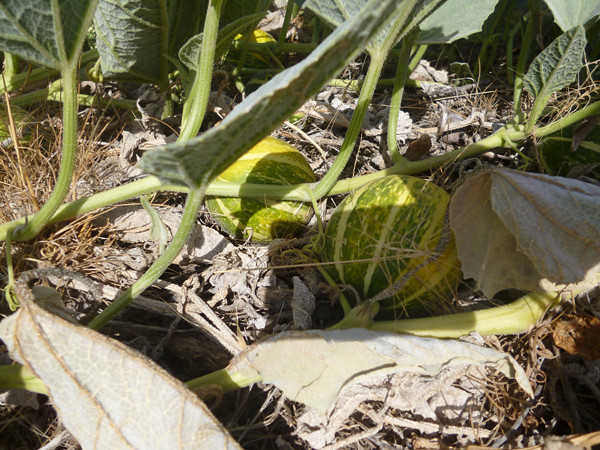ISEA 2012: Wild Edible Plants Walk
Posted Sept. 29, 2012 by Theun KarelseThe 2012 International Symposium on Electronic Arts was held this year in the New Mexico desert city of Albuquerque. The crickets and birds in this dusty city between the mountains make for an orchestra that is the perfect accompaniment to the symposium theme, 'Machine Wilderness'. Sounding like sonar systems, windscreen wipers, sprinkler systems or other types of weird machinery, the local 'critters' provide a pretty surreal soundscape.

During the 'Block Party', which is the outdoor component of the festival, FoAM hosted a wild edible (or otherwise useful) plant walk starting from Central Ave and 6th Street right along Route 66 in the centre of town. From the moment we arrive it's clear we overestimated the amount of plant life in the American desert. This is cactus country, folks! There are hardly any plants we know from Europe. We seriously need help from local experts.
Typical view of the urban desert in Downtown Albuquerque
Maria J. Thomas works at the impressive Botanic Gardens of the ABQ BioPark. We arrive on foot and simply enter the available first door: it turns out to be the back door of the Aquarium restaurant! Eventually we meet up with Maria and get an excellent crash course on edible and medicinal desert plants, going behind the scenes at the Botanic Gardens looking for some native weeds. Maria is very knowledgeable and kindly answers all our questions.
Maria behind the scenes at the ABQ Biopark
The plant expedition is set for the last Sunday of the symposium, during the Block Party. Here are some highlights from the walk. We take Maria's tips and notes to help us determine what the plants are.
The prickly pear cactus (Opuntia spec.) is intensely hated now, but was used as a vegetable and medicinal plant throughout this region by the Native Americans. It looks fantastic! Like a plant Mickey Mouse with red fingers. One of the ISEA talks by April and Matthew, who have also joined our walk, deals specifically with reintroducing this plant to residential areas as a bridge to forgotten practices. Apparently you can just chop off any of it's juicy 'ears' and stick them in the ground to grow a new plant.
Our absolute favorites must be goathead (Tribulus terrestris), the bodybuilders herb! This inconspicuous little cover plant contains chemicals that build up muscle and is therefore used by weightlifters and bodybuilders! Fantastic. Somehow a real American species, we think.
City policy on management of parks and sidewalks always has a big impact on the availability of wild plants. Cities in New Mexico seem to be very strict; sidewalks are made of concrete slabs and the niches between them are filled with some kind of glue that seems to make it impossible for herbs to gain a foothold. Only the occasional crack offers a habitat. Most green spaces have anti-rooting membranes in place too.
April and her son exploring the urban wilderness beneath a desert willow
During the plant expedition we discover some very surprising characters. This intriguing fruit-bearing tree has many brown fruits that smell and look very edible. We ask a local neighbor hiding behind her amazing amaranth plants and she tells us they are chinese dates or jujube (Ziziphus zizyphus). They have an mysterious apple-like taste and are best when they turn just a bit wrinkly. Nobody seems interested in the tree, so we gather a nice bunch – for date pie perhaps?
A neighbour hiding behind her amazing amaranth plant
Monica, who is very knowledgeable about local plants, insists that this mullein (Verbascum spec.) provides the desert's best source of toilet paper, and indeed the leaves feel very soft; in fact this plant feels better than any toilet paper anyway! The major use for mullein (besides toilet paper) is for asthma and respiratory ailments, but Maria adds that the plant is high in rotenone and so should be used sparingly and only if nothing else is available.
On our return walk we find the buffalo gourd (Cucurbita foetidissima), an indiginous wild pumpkin. It has relatively small fruits, but they do look wonderful. We've brought one back to Europe to try and grow in FoAM's Edible Garden in Amsterdam West. Although Maria mentions that they are very bitter, they can be used to make rattles, bird cages, and apparently also soap.
Stay tuned for more plant info coming up in a PDF booklet soon…
Created: 15 Jul 2021 / Updated: 15 Jul 2021
















